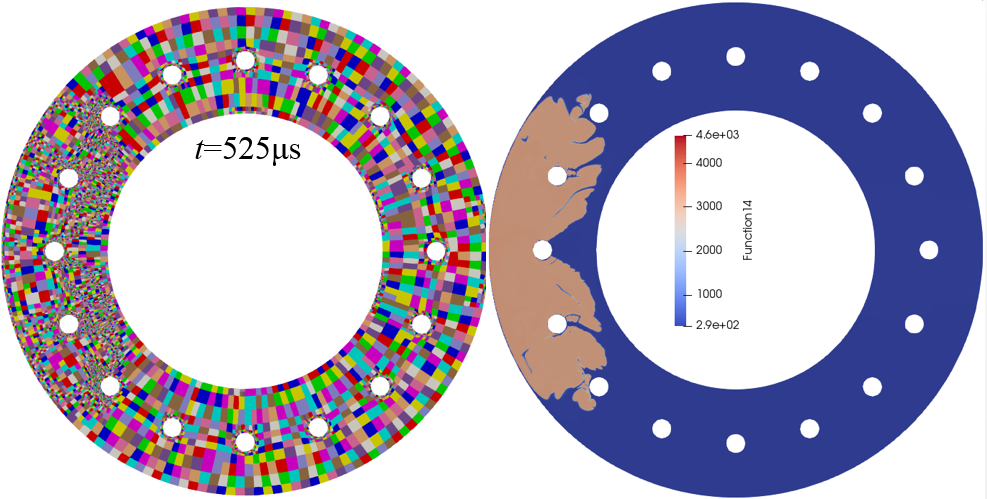Numerical investigation of combustible flows using the adaptive mesh refinement (AMR)
JAXA Supercomputer System Annual Report April 2018-March 2019
Report Number: R18EACA35
Subject Category: JSS2 Inter-University Research
- Responsible Representative: Tang xinmeng, Edyta Dzieminska, A. Koichi Hayashi, Sophia University
- Contact Information: Tang Xinmeng, Sophia University, simondonxq@gmail.com(simondonxq@gmail.com)
- Members: Edyta Dzieminska, Hajime Sakai, Yuichi Niga, Syota Yamamoto, Xinmeng Tang, Koichi Hayashi, Koki Kobayashi, Wataru Koido
Abstract
This study is to numerically simulate combustible flows (especially hydrogen-air) with the adaptive mesh refinement so that the combustible features, flame propagation, deflagration to detonation transition (DDT) together with detonation can be further understood with more details. Due to the code situation and the core time cost, the planed calculations of jet ignition were not carried out on a large scale. Instead, the continuous development of codes has been done in the last year and several test combustion cases using AMR are performed which are not of a large scale. Adaptive mesh refinement methodology is assembled onto general curvilinear system in order to do AMR simulation for complicated non-rectangular shapes and models. Combustion simulations in an S-shaped tube and a disc annulus with obstacles are performed. It is found that the AMR system can work well in the non-rectangular models and the reaction flows can be simulated by this flexible AMR mesh system.
Reference URL
N/A
Reasons for using JSS2
Numerical calculations for combustible flows in 2D and 3D physical models require a lot of CPU cost. On one hand, the timestep is usually very small due to the high pressure and high pressure which results in a high local sonic speed. This timestep is usually of a range of 1 or 1/10 nanosecond. On the other hand, the requirement of high resolution results in a big grid quantity even with AMR. These make the simulation in 2D or 3D large-scale calculations. Therefore, the supercomputer would be necessary for use to perform such a research. Without it, we cannot get a valid CFD result.
Achievements of the Year
1. Xinmeng Tang, Edyta Dzieminska, A. Koichi Hayashi, Nobuyuki Tsuboi, Gradient mechanism on the onset of detonation in the deflagration to detonation transition, ICDERS27th, Beijing, 2019.
2. A. Koichi Hayashi, Nobuyuki Tsuboi, Xinmeng Tang, Edyta Dzieminska, Numerical analysis on detonation and detonation application using adaptive mesh refinement, Seventeenth International Conference on Numerical Combustion, Aachen, May 6-8, 2019.
3. Adaptive mesh refinement methodology is assembled onto General curvilinear system in order to do AMR simulation for complicated non-rectangular shapes and models.
4. Combustion flows in an S-shaped tube and a disc annulus with obstacles are performed.

Fig.1: Combustion simulation in an S-shaped tube with AMR methodology. The top and left part presents the AMR block system inside the physical domain, while the top right part shows the grid mesh points. Below are the Ma number and u velocity, respectively.

Fig.2: Combustion simulation in a disc annulus with AMR methodology. The left part shows the AMR blocks and the right part represents the temperature distribution of this reaction flow.
Publications
– Oral Presentations
1. Xinmeng Tang, Edyta Dzieminska, A. Koichi Hayashi, Nobuyuki Tsuboi, Gradient mechanism on the onset of detonation in the deflagration to detonation transition, ICDERS27th, Beijing, 2019.
2. A. Koichi Hayashi, Nobuyuki Tsuboi, Xinmeng Tang, Edyta Dzieminska, Numerical analysis on detonation and detonation application using adaptive mesh refinement, Seventeenth International Conference on Numerical Combustion, Aachen, May 6-8, 2019.
Usage of JSS2
Computational Information
- Process Parallelization Methods: MPI
- Thread Parallelization Methods: Automatic Parallelization
- Number of Processes: 4 – 320
- Elapsed Time per Case: 1000 Hour(s)
Resources Used
Fraction of Usage in Total Resources*1(%): 0.02
Details
Please refer to System Configuration of JSS2 for the system configuration and major specifications of JSS2.
| System Name | Amount of Core Time(core x hours) | Fraction of Usage*2(%) |
|---|---|---|
| SORA-MA | 91,669.06 | 0.01 |
| SORA-PP | 5,290.04 | 0.04 |
| SORA-LM | 0.00 | 0.00 |
| SORA-TPP | 0.00 | 0.00 |
| File System Name | Storage Assigned(GiB) | Fraction of Usage*2(%) |
|---|---|---|
| /home | 28.61 | 0.03 |
| /data | 286.10 | 0.01 |
| /ltmp | 5,859.38 | 0.50 |
| Archiver Name | Storage Used(TiB) | Fraction of Usage*2(%) |
|---|---|---|
| J-SPACE | 0.00 | 0.00 |
*1: Fraction of Usage in Total Resources: Weighted average of three resource types (Computing, File System, and Archiver).
*2: Fraction of Usage:Percentage of usage relative to each resource used in one year.
JAXA Supercomputer System Annual Report April 2018-March 2019


